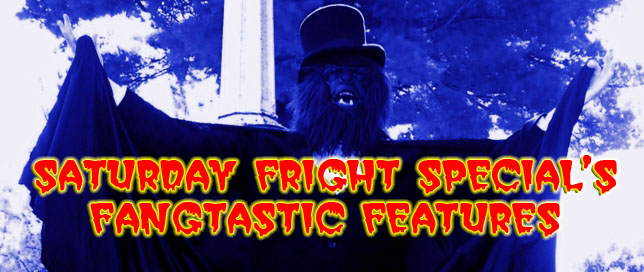 Reviewed by Rick Trottier
Reviewed by Rick TrottierFor those movie-lovers who are enamored with vintage horror flicks, few names have more cachet than Hammer Films. Begun in 1934, by the 1950s, Hammer was producing a series of films based on the Universal monster franchises of the 1930s and 1940s that brought immediate commercial success and notoriety to the British-based company. By the 1960s, the “Hammer formula” was in full swing and motion pictures about Dracula, Frankenstein, the Mummy, the Wolfman, as well as all kinds of other legendary monsters were being churned out. Hammer was a diverse studio though, and thrillers, science fiction and fantasy as well as mythological tales and mysteries were also produced during the company’s noontide. By the mid-1970s, film tastes and low-budget competition brought about an eventual decline that led to an end in production of films in 1979. By the mid-1980s, even Hammer's television series had faded away. What Hammer can claim that only a few other studios can also say is that they left an indelible impression on the minds of horror mavens everywhere. Sony Pictures has collected four of Hammer’s lesser known classics released by Columbia Pictures in the early 1960s; THE TWO FACES OF DR. JEKYLL (1960), CURSE OF THE MUMMY’S TOMB (1964), THE GORGON (1964) and SCREAM OF FEAR (1961). While not as well known as films like CURSE OF FRANKENSTEIN (1957), DRACULA (1958) and THE MUMMY (1959), this outstanding collection is every bit the equal of Hammer’s best creations in both style and substance.
Packaged in a two-disc set, there is a superb symmetry to the arrangement of these four films. On disc 1 can be found THE TWO FACES OF DR. JEKYLL and CURSE OF THE MUMMY’S TOMB, both of which have a lot in common and complement each other well. On disc 2 reside THE GORGON and SCREAM OF FEAR, which are also sisters in style to a surprising degree. THE TWO FACES OF DR. JEKYLL, directed by Terence Fisher and starring Paul Massie (Henry Jekyll and Edward Hyde), Dawn Addams (Kitty Jekyll) and Christopher Lee (Paul Allen) is the age-old story of scientific researcher Dr. Jekyll, who is on a quest to unlock the secrets of mankind’s darker behaviors and control them. He knowingly unleashes a sinister force upon 1874 London in the form of Edward Hyde and then battles to manage and eventually subdue this fiend, all at the cost of those around him. CURSE OF THE MUMMY’S TOMB, directed by Michael Carreras and starring Terence Morgan (Adam Beauchamp), Ronald Howard (Dr. John Bray), Fred Clark (Mr. Alexander King), Jeanne Roland (Annette Dubois) and Jack Gwillim (Sir Giles Dalrymple) is the story of the Dalrymple expedition, which returns from Egypt in 1900 with the mummy and treasures of Prince Ra, the son of Ramses VIII. When the sarcophagus is opened, an ancient curse is initiated and all those involved with the expedition come under its shadow. THE GORGON, directed by Terence Fisher and starring Peter Cushing (Dr. Namarov), Christopher Lee (Professor Meister), Barbara Shelley (Carla Hoffman) and Richard Pasco (Paul Heitz) is the story of the town of Vandorf, Germany in 1910 and its proximity to the cursed Castle Borski. A terror inhabits the castle in the form of Megara, one of the three Gorgon sisters, who turns anyone to stone who gazes upon her face. Horrifying and inexplicable deaths bring learned men from Berlin and Leipzig to battle this monster and put an end to the fear she has spread over the town. Finally, SCREAM OF FEAR, directed by Seth Holt and starring Susan Strasberg (Penny), Ann Todd (Jane), Ronald Lewis (Bob) and Christopher Lee (Dr. Gerard) is the a modern story of young Penny Appleby, a physically and psychologically damaged woman who returns home to the Cote D’Azur after ten years to become enmeshed in sinister schemes and maniacal machinations designed to unseat the last pillars of her sanity. Penny is forced to turn from threat to threat, never knowing whom she can trust until the final acts of violence are visited upon her.
THE TWO FACES OF DR. JEKYLL and CURSE OF THE MUMMY’S TOMB are an outstanding pairing, for these two films are the most visually stunning. Both films depend on sumptuous sets and costuming, both are replete with lavish props, décor and background paintings as well as mesmerizing colors painstakingly dappled and stippled throughout every scene. If any films were to ever topple Mario Bava’s works from the pedestal of “most colorfully and imaginatively lit” it would be this duo. From the start, both THE TWO FACES OF DR. JEKYLL and CURSE OF THE MUMMY’S TOMB are a feast for the eyes and the banquet of spectacular imagery never dissipates. Whether it is the grandiose interior sets, the gorgeous actresses bedecked in all manner of extravagant fashions or the camera work that does all it can to maximize the sheer beauty of each scene’s composition, the end result are two films that are equally stylish and immediately call to mind the word
voluptuous. In the case of THE TWO FACES OF DR. JEKYLL, there is a curious contrast between the hedonistic world Mr. Hyde lives in, exemplified by the almost garish color scheme of each set, and the sedate and almost morose universe of Dr. Jekyll, still replete with interesting images, but not evidencing the same intense palette. When it is CURSE OF THE MUMMY’S TOMB, the grandeur of the filmmaking canvas is meant to recall both the splendor of ancient Egypt and Edwardian High Society, but done in such a manner as to be as magnificent and as opulent as possible.
THE TWO FACES OF DR. JEKYLL and CURSE OF THE MUMMY’S TOMB are not all style over substance and both movies benefit from being superbly cast, very well acted and both stories have enjoyable twists woven into their well-traveled tales. Instead of going the usual route of making him a monster, in THE TWO FACES OF DR. JEKYLL, it is Dr. Jekyll who is the outcast and the physically unappealing character. In contrast, Mr. Hyde is urbane and amiable, but with a streak of savagery and sadism that are the faults that bring about his eventual demise. In CURSE OF THE MUMMY’S TOMB, instead of the tired story of the millennia-spanning love of the priest for a unattainable princess, it is a bloody and brutal brotherly rivalry that is the core of the curse cast on all who have dealings with Prince Ra. In addition, both films’ narratives nicely intertwine love triangles, double-crossings and dirty dealings as well as avarice and lust. THE TWO FACES OF DR. JEKYLL is possibly the most salacious mainstream film I have ever seen to come out of the early 1960s and is a parade of sins and a whirlpool of vices strung across the screen in as lurid a fashion as gypsy veils. CURSE OF THE MUMMY’S TOMB is not as spicy, but it is just as violent and incorporates just as many human frailties, making it an equally compelling joy ride, all packaged in the customarily delightful manner of Hammer cinema that had all the appeal of MGM films at their gaudy height in the 1940s and 50s.
While still visually engaging in their own fashion, THE GORGON and SCREAM OF FEAR are not about spectacle and splendor, these films are about atmosphere and mood. THE GORGON is a tale of misty forests, menacing castles and malevolent spirits, all creating misery in a little town that has a modicum of mendacity about it. Whether it’s cobwebby corridors, ghostly graveyards or rambling ruins, THE GORGON is dependant upon developing a feeling of suspense that causes this motion picture to border upon the genre of mystery more than it does horror, but when coupled with elements of mythology, a potent combination is birthed. Even though THE GORGON is a color motion picture, brightness and brilliance are not the focus. Every time the full moon rides the sky and terror stalks the night, the effort expended to create the visual outcome is meant to feel ominous and deeply threatening. SCREAM OF FEAR, the only black & white film in this collection, has a similar feel. However, instead of developing its sense of suspense and threat via the use of mythological monsters, this movie is all about the frightening pathways of the mind in its dealings with trust and deception, baleful plots and sadistic schemes as well as familial bonds broken by bad intentions. SCREAM OF FEAR has many of the same classical architectural qualities as does THE GORGON, but just like that film, they are window dressing and meant only to intensify the billowing moodiness of the plot.
Both films are just as well cast and well acted as THE TWO FACES OF DR. JEKYLL and CURSE OF THE MUMMY’S TOMB. While THE GORGON has the “Old World” dignity and charisma of the combined talents of Peter Cushing and Christopher Lee, SCREAM OF FEAR has Susan Strasberg’s enigmatic glamour and innocent sex appeal. All through THE GORGON, we are treated the consummate Cushing and Lee tag-team assault of supremely genteel and aristocratically commanding acting that holds an audience spellbound with its power. There was a chemistry those two gentlemen shared in their many films together that has been rarely equaled. In direct contrast, Susan Strasberg’s softly modulated yet highly charged emotional impact of her facial expressions and astonishingly intense but girlish voice carry the weight of many performances in SCREAM OF FEAR. If you want to bask in films that are a little more cerebral and are the kind of movies you want to watch late at night with the lights off and a thin blade of moonlight peaking through the curtains, these will fit the bill admirably.
Finally, what makes all this enjoyment possible is an outstanding visual and audio transfer by Sony Pictures. These films have probably not looked this good since their release. All four films are crisp, clean and bright looking and the sound is absolutely impeccable. To see four such films preserved in a state where they will likely never look too much better than this is an absolute boon for the “Hammer-loving” horror hound. Sadly, the extras menu of this two-disc set is a little thin, but it for understandable reasons. You can delight in the original theatrical trailers of all four films and gape at the fact that they are in pristine condition. It is often the case that while the feature film will receive the best possible transfer for a special dvd release, usually the trailers are in bad shape and tend to look pretty bad as a result. In this case, these four Hammer trailers may never have looked this good, for certainly trailers took a lot of abuse in their rounds from theater to theater and to see these theatrical trailers look this impressive makes up for some of lack of other bonus features. When one considers that most of the cast and crew of these films have since gone to their reward, not having any updated interviews or short features is understandable. What few luminaries are still with us live far away “across the pond” and may have failing memories or health. Just having these lesser known gems look so spectacular is enough for once.
There are a large number of collector’s editions and multi-disc packs that amass some pretty impressive compilations of films. This is one of the most enjoyable viewing experiences I have had in some time. To be able to glory in films that are well written, superbly shot, expertly cast, charismatically performed and splendidly preserved restores some of my faith in humanity. If all of life’s experience could be so unstained and peerless, nirvana could possibly be attained on these poor mortal shores. Don’t pass up the chance to get this set. Support projects like this one so that others will come forth. You won’t be sorry.
www.sonypictures.com










